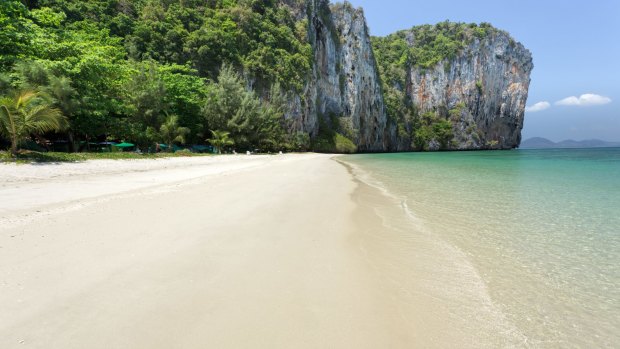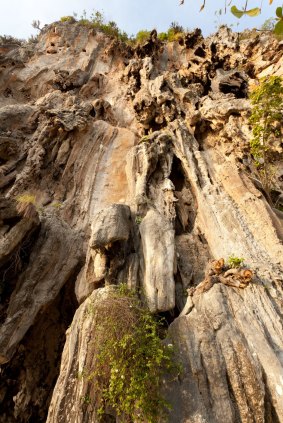This was published 7 years ago
Koh Laoliang: Better than 'The Beach' - Thailand's undiscovered island
By Louise Southerden

Beach of Koh Laoliang in Thailand.Credit: Alamy
It's The Beach, a fellow traveller had told me during a climbing course in Krabi, southern Thailand. Beautiful, untouched, with great limestone walls, he'd said, and without the suicidal Scot, the tyrannical Tilda Swinton and the mass tourism that ruins nearby Koh Phi Phi Leh (where the movie version of Alex Garland's novel was shot) on a daily basis.
A few days later I'm on my way to Koh Laoliang, which is something of an anomaly in Thailand: a remote island national park ringed by a marine reserve with one perfect beach free of longtails and blissfully uncrowded – because daytrippers aren't allowed, there are no bungalows or resorts and only 50 people can stay at a time, in a tented camp that's open only five months of the year (October-April).
Just getting there is a little adventure. I don't have to swim with my backpack in a garbage bag like "Richard", played by Leonardo DiCaprio in the movie, but I do have to take a motorbike, a bus, a taxi and two longtails to reach Laoliang, in neighbouring Trang province, from Krabi. (It's easier from Trang airport.)

Laoliang is best known in climbing circles for its bolted sport climbs. Credit: Alamy
The last longtail ride is my favourite part, speeding over a turtle-green Andaman Sea watching flying fish, diving seabirds and our looming destination: twin karst islands 20 kilometres offshore.
Forty-five minutes later the boat noses ashore and I step from its bow onto North Laoliang Island and its unbelievably lovely beach. Clean, with dazzling sand devoid of footprints, it's lapped by swimming pool-clear water and enclosed on three sides by 100-metre climbing walls. Then there's the accommodation.
The island's Thai hosts call it "sea camping" and I can see why. There are 20 tents right on the beach, all facing the sea. More spacious and comfortable than I'd expected, mine has two rooms: a bedroom with two single mattresses on the floor made up with sheets, pillows and blankets; and a roomy vestibule with a fan and a light (the generator comes on at 4pm so guests can also charge their devices overnight).
Laoliang is best known in climbing circles for its bolted sport climbs starting on the beach and rope ladders that dangle into the water at high tide, but there are plenty of non-climbers here too: couples, a few solo travellers like me and families with young, free-range children.
Whatever has drawn us to this little island, everyone seems to agree on what makes it special: it's peaceful and sublimely simple.
There are no boats speeding past day or night. There's no Wi-Fi or mobile reception. You can walk everywhere barefoot and take off your watch: the sun is your alarm clock, rising at a civilised 7am during my visit. Meals are served buffet-style in a thatched open-air "dining room" and a small bar with a bamboo deck strewn with cushions plays music in the evenings, but never loudly enough to disturb those in the nearest tents or sitting quietly on the beach enjoying the nightly star-show.
It's the kind of place where people do yoga on the beach or have a dip before breakfast. After breakfast, you can swim out to a small reef with a mask and snorkel, paddle a kayak to South Laoliang (larger than North Laoliang, and even more untouched), go deep-water soloing (scaling sea cliffs without ropes and falling safely into deep water) or just laze in a hammock with a book.
Afternoons are for climbing, if you're so inclined, when the east-facing walls are in the shade (it's too hot in the mornings).
Like The Beach, Laoliang isn't for everyone. It's a bit pricey, for a tent, in Thailand, although the tariffs are all-inclusive. You have to sleep on the floor and use a communal bathroom (one for men, one for women), there's no hot water and the food is basic, which is surprising given that a longtail brings new guests and supplies from the mainland every day and, well, this is Thailand.
But if you've ever yearned for a simple, castaway holiday in a tropical place where nature, not what's on the menu, takes centre stage, Laoliang might suit you fine. It's reassuring to know places like this still exist in Thailand and that they're not hard to find, if you keep your ear to the ground. No hand-drawn treasure maps required.
FIVE MORE THAI NATURE EXPERIENCES
1. FLOATING BUNGALOWS
Stay in a traditional bamboo raft-house on Khao Sok Lake in Khao Sok National Park, southern Thailand, for front row wildlife-viewing. There are also tours to see wild elephants and camp in the jungle. See khaosoklake.com
2. ELEPHANT EXPERIENCE
Elephant Nature Park on the outskirts of Chiang Mai is a sanctuary for 30 mistreated elephants, a place to watch them doing their thing (no riding allowed); there are also overnight and one-week volunteer stays for a more hands-on experience. See elephantnaturepark.org
3. BANGKOK TREE HOUSE
You don't even have to leave Bangkok to experience nature. This bamboo, vegan-friendly eco-hotel on the Chao Phraya River is accessible only on foot, by bike or by boat and has rooms with names such as "bee hive" and "tree-top nest". Rooms from 4750 baht, including breakfast, Wi-Fi, bike rental and icecream! See bangkoktreehouse.com
4. UNDERWATER WONDERS
The Similan archipelago in the Andaman Sea, 90km north-west of Phuket, is one of the best places to dive in Thailand, and has been a marine park since 1982. Go between February and April to see manta rays and whale sharks, and maximise your dive time with a live-aboard trip. See divebooker.com
5. BIKING THE BORDERLANDS
Bangkok-based Grasshopper Adventures has a nine-day bike trip that explores the mountains bordering Laos in Thailand's north and Phu Soi Doi, one of Thailand's newest and most remote national parks, famed for its pine forests. See grasshopperadventures.com
TRIP NOTES
MORE INFORMATION
GETTING THERE
Nok Air and Air Asia fly daily from Bangkok to Trang, see nokair.com, airasia.com. From there, it's 50 minutes by car then 45 minutes by longtail to the island. There are also bus-and-boat transfers from Krabi. See laoliangisland.com.
STAYING THERE
Because most guests stay at least two nights, there's a three-day package for 6500 baht per person (3900 baht for children under 10), which includes two nights' accommodation, transfers from Trang airport, all meals (but not alcoholic drinks) and snorkelling gear. The island is open only during the dry season, from October 15 this year to April 30, 2017. See laoliangisland.com
Louise Southerden travelled at her own expense.
See also: 20 things that will shock first-time visitors to Thailand
Sign up for the Traveller Deals newsletter
Get exclusive travel deals delivered straight to your inbox. Sign up now.